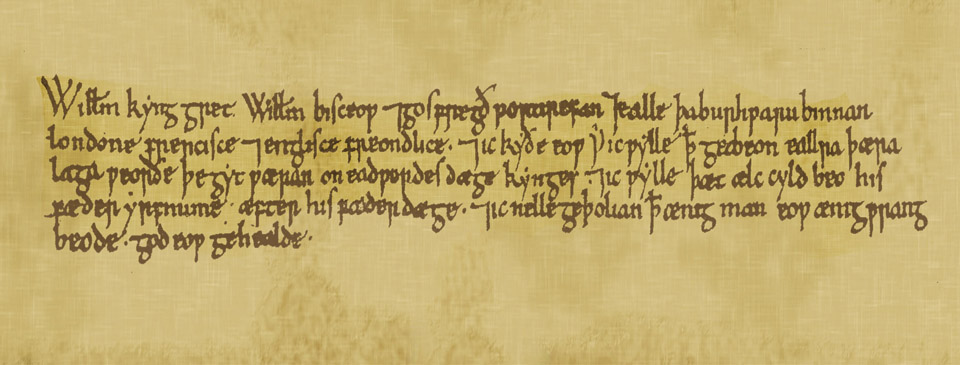In Brief – Saxons, Vikings and Normans

The text of the charter of reassurance issued to the people of London by William the Conqueror shortly after his coronation.
Subsequent Saxon kings of the 10th century gradually gained territory from the Vikings. Without the threat of attack the port of London flourished. During that time the town was divided into twenty wards, each headed by an ‘earlderman’ (the origin of the word ‘alderman’), with a ‘port-reeve’ (or ‘shire-reeve’, the origin of the word ‘sheriff’) assisted by ‘bailiffs’ responsible for collecting taxes.
Viking attacks on London began again at the end of the 10th century. In 1012 they captured Alphege, Archbishop of Canterbury and murdered him at Greenwich. London finally fell to Sweyn, the Danish king, the following year and the Saxon King Aethelred (the Unready) fled to Normandy. He returned with Olaf (or Olave) of Norway and they found London Bridge heavily defended. The legend is that they tied their ships to its wooden piles and, using the tide, dislodged and destroyed the bridge, drowning many of its defenders and giving us the rhyme ‘London Bridge is Falling Down’. London was recaptured, Olaf was later canonised, and six churches dedicated to him were built in London and Southwark.
Aethelred’s and Sweyn’s successors, Edmund Ironside and Cnut, continued the fight for possession of England. Edmund was assassinated in 1016 and the English crown passed to Cnut, thus uniting England and Denmark. King Cnut, a Christian, built a palace beside the church that had originally been established by St. Dunstan’s monks on the island of Thorn Ea (or Thorney) several miles upstream of London.
Many of London’s oldest parish churches were founded during the reigns of Alfred and Cnut. They included St. Gregory’s (immediately beside St. Paul’s and later incorporated into that building); Holy Trinity, Aldgate; St. Augustine (to the east of St. Paul’s); St. Martin le Grand (north of St. Paul’s); St. Peter ad Vincula (later incorporated into the Tower of London where it still remains) and St. Helen’s, Bishopsgate. St. Clement Danes, St. Bride’s, St. Nicholas Acon and St. Olave, Hart Street were all dedicated to saints popular with Christian Vikings.
Upon the death of Cnut’s son and successor Hardicnut at Lamb’s-hithe (Lambeth) in 1042 the Saxon lineage resumed with King Edward (the Confessor). Soon after he began work on a vast new abbey at Thorn Ea dedicated to St. Peter and it became known as Westminster – the minster to the west. Edward had an uneasy relationship with London and in 1053 had a fine new stone palace constructed at Westminster, replacing Cnut’s earlier building, and probably abandoning the older Wardrobe Palace close to St. Paul’s. Thus, London continued as a port and commercial centre and, in the following centuries, Westminster became the centre of royalty and government.
King Edward and his wife failed to produce any children. There was an issue regarding who would succeed him, with conflicting promises given to several potential heirs. According to later Norman accounts, on his deathbed at the beginning of 1066 Edward promised the crown to his brother-in-law Harold, Earl of Wessex, who was crowned at the adjoining and newly-built Westminster Abbey. Since then the coronations of all English monarchs except two have been held at the abbey, up to and including Elizabeth II in 1953.


